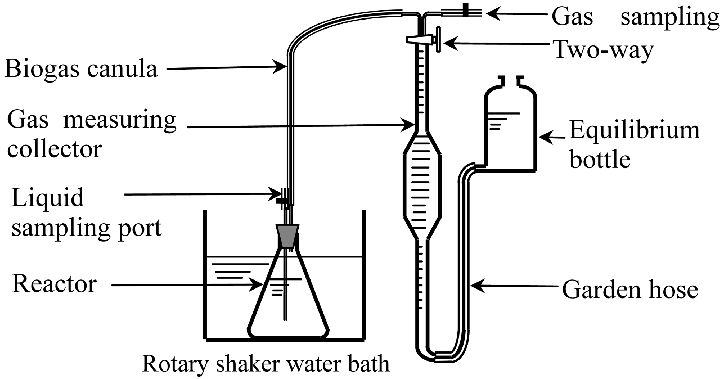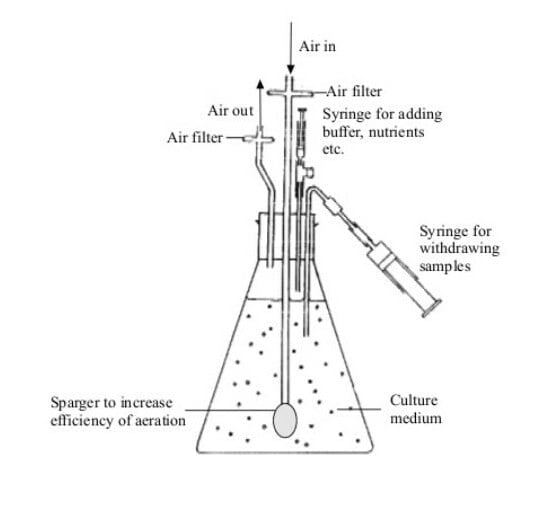One kind of microbial culture method is batch culture, in which microorganisms are grown in a closed environment using a set amount of nutrient material. During the cultivation process, the culture is neither continuously deprived of waste materials or given extra nutrients.
Table of Contents
- Sterilization is the first step in a batch culture, and after that, microorganisms (approximately 2–5% of the total volume) are added to the sterile culture.
- The temperature differential that occurs throughout the reaction cycle as well as the proportions of vitamins, nutrients, and microbiological cells in the reaction mixture.
- They maintain acceptable concentrations and temperatures when mixed properly.
- The procedure is conducted in anaerobic conditions with the addition of acidic or alkaline solutions to regulate pH, and oxygen is bubbled in or out.
- When a foam sensor signals the need for antifoaming agents, they are added.
Principle of Batch Culture
The basic idea behind this is to cultivate microorganisms in an environment rich in nutrients until the resources are exhausted or the growth conditions are no longer ideal. There are four major development phases that the culture goes through: lag, exponential (log), stagnant, and death.

Process of Batch Culture
- Inoculation: A bioreactor or flask is a closed vessel that contains a sterile nutritional medium into which a tiny volume of microbial culture (inoculum) is added.
- Lag Phase: Microorganisms adjust to their new surroundings upon inoculation. During this phase, cells adapt their metabolism to the available nutrition and little to no cell division takes place.
- Exponential (Log) Phase: Cells divide quickly and continuously, which causes exponential growth. This phase is perfect for researching microbial physiology and kinetics because it has a steady growth rate.
- Stationary Phase: Growth is slowed down by nutrient depletion and waste product accumulation. A constant population size is achieved when the rate of cell division and death is equal.
- Death Phase: When the rate of mortality exceeds the rate of growth, nutrient exhaustion and toxic waste accumulation lead to a decrease in the viable cell population.

Applications of Batch Culture
Microbial Growth Studies: It offers a straightforward and regulated setting for researching the physiology, growth dynamics, and effects of various circumstances on microbiological growth.
Bioproduct Production: Antibiotics, enzymes, vitamins, and other microbial metabolites are produced via batch culture. To maximize product yield, the high cell density during the exponential phase is beneficial.
Research and Development: It is an essential technique in laboratory research for small-scale experimentation, hypothesis testing, and the screening and optimization of microbial strains.
Education: In order to help students comprehend the dynamics of microbial development and experimental methods, it is a crucial approach in the teaching of microbiology and biotechnology.
Limitations of Batch Culture
While batch culture is widely used , it has several limitations:
Nutrient Limitation: Nutrient depletion occurs during the culture process, which may restrict cell growth and production.
Waste Accumulation: Toxic byproduct buildup can impede the growth and metabolism of microorganisms, hence impacting the general health of the culture.
Finite Duration: It is less suited for long-term continuous processes because of their limited lifespan caused by waste accumulation and nutrient depletion.
Non-Uniform Conditions: Variations in the growth rates and metabolic activities of the cells can result from varied conditions within the culture vessel throughout time.
Scale-up Challenges: It can be difficult to scale up from laboratory to industrial size because of variations in nutrient distribution, mixing, and oxygen transfer.
Conclusion
A fundamental method in microbiology and biotechnology, batch culture offers important insights into the development and metabolism of microorganisms. It is perfect for a variety of applications, from fundamental research to the industrial production of bioproducts, due to its controllability and simplicity.
Its drawbacks, including as waste buildup and nutrient depletion, draw attention to the necessity of other growing techniques, like fed-batch and continuous cultures, for specific applications. Comprehending the fundamentals and methodology of batch culture is imperative for the efficacious application of this methodology in diverse scientific and industrial settings.
Frequently Asked Question(FAQ)
What do you mean by batch culture?
A closed culture system with restricted nutrient availability is called batch culture. In batch culture, cells are typically kept in conical flasks on orbital shakers at a speed of 80–120 rpm while growing in a finite volume of liquid media.
Why is batch culture used?
One of it’s benefits are: brief in duration. Because no nutrients are provided, there is less danger of contamination. batch material separation for traceability.
What are the disadvantages of batch culture?
Due to its considerable downtime—nonproduction time spent on cleaning, sterilizing, and launching a new batch cultivation—during two batch cultivations, batch cultivation’s main drawback is its low productivity.
Related Article


